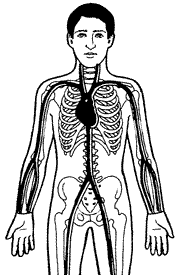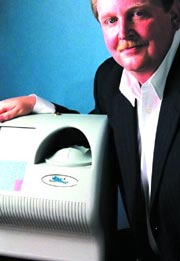WHILE PRIVACY WATCHDOGS have been fretting over cookies and Internet tracking, dozens of off-line companies have sought possibilities for putting bar codes on every imaginable part of the human body and rolled out products for more traditional Big Brother-type monitoring.
The name of the game is biometrics, in which unique biological identifiers are captured, mapped, and stored to provide added security and convenience—though sometimes at the expense of privacy.
The future portrayed in the 1997 film Gattaca hasn’t quite arrived, as DNA prints are still far from instantaneous, but many companies are competing, especially in recent months, to become the standard and accepted form of validating—or even discovering—identity.
Biometrics companies aim to protect private information and provide conveniences to consumers. Consumers could access locked doors, computers, and Web sites with nothing more than a touch of the finger or an eye scan.
These simple solutions enter murkier, not-yet-navigated legal waters when exploring what happens to databases filled with biometric information. If an individual volunteers a fingerprint or eye scan to a Web site or ATM, can that person be guaranteed that no third parties will have access to that private—and easily searchable—information? And in a matter of urgency, couldn’t the government get a court order to access supposedly private information whenever necessary?
More troubling are the companies developing surveillance products (see chart) that will enable the study of random people for comparison to a database of terrorists and criminals—potentially without their being aware of it. The technology gives law enforcement the power to suspect lots of people, but its ability to truly identify criminals at large is still unproven.
Eye scanning and imaging
Retinal-scanning and iris-imaging technologies, while having the greatest James Bond appeal, appear to be half a step behind competing technologies. Retinal scanning is accurate, but clunky and rigorous. Iris imaging, which is marketed for identity validation, is alternately accused of being too invasive for people to use and being open to surveillance of unwitting citizens. A spokesperson for Iridian Technologies says a subject has to be 18 inches from a camera for 2 seconds—not useful for surveillance purposes.
Voice recognition
Voice-recognition technology is used for pass-code access because it’s good at recognizing specific individuals. However, the larger the group of users grows, the more the error rate increases—which means very few surveillance and law-enforcement uses so far.
Palm prints
NEC, which has digitized fingerprints since the early ’80s, recently began keeping records of palm prints, contending that records of both can only help police solve crimes. A Puyallup, Wash., company asserts that its technology for scanning under the skin of the palm is more secure, without Big Brother overtones. [See “Chat Room,” p. 27.]
Fingernail-bed scanning
AIMS, a South Carolina company, says that underneath the fingernail, we all have something like a bar code—and that it can be scanned by a laser (like at a checkout counter) for secure access. The technology boasts the advantages of being voluntary and not surveillance oriented, but is still vaguely creepy.
Face scans
Viisage face-recognition technology made headlines when surveillance cameras scanned the crowds at Super Bowl XXXV, allegedly picking out 20 felons. None were apprehended, however, so it’s unknown how accurate this technology was. Viisage’s competitor, Visionics, has used an extensive network of cameras in the Newham borough of London for two years, claiming crime has since dropped 40 percent. Few arrests have been made using this technology in the United States, and the Seattle Police Department (perhaps content with its expert handling of the Mardi Gras riots) says it has “no plans” to use it, according to a spokesperson. Burning legal issue: A user can set an accuracy threshold, which dictates how exact a match the computer seeks. In a time of crisis, does this mean that the threshold will be set lower and numerous innocent people will become suspects?
The two leading face-recognition companies also market an ID verification product for cash machines. Innoventry, with heavy investment from Wells Fargo, recently set up check-cashing machines at several QFC supermarkets in Seattle. The machines ask for a Social Security number, snap a picture, and give you cash for your check (after taking a percentage). For those who can’t open a bank account, the (somewhat) attractive rates encourage an erosion of privacy—having one’s photo on file. Although the company promises privacy, a subpoena could ostensibly overcome that.
Fingerprints
Identix and other fingerprint companies are pushing their products as providers of secure access to computers and e-commerce sites, bragging of the elimination of numerous passwords. A spokeswoman for Identix says she is unsure whether law enforcement would want to tap into commercial databases to search for criminal fingerprints. But she adds that it would only keep criminal elements from using certain Web sites and that “as an innocent, I am not threatened by whatever the FBI or police do with my fingerprint data; their weeding out criminals from where I am shopping or chatting should serve to protect me as a registered, identified, noncriminal user.” Is everyone as comfortable with that as she is?
ID cards
Becoming associated with the driver’s license—a nearly universal ID—is a golden apple for many biometrics companies. Face-recognition and fingerprint companies are the most eager to become involved. Washington’s Department of Licensing, which only recently (and reluctantly) began collecting Social Security numbers from applicants, has no plans to use either technology. Spokesman Mark Varadian says that the DOL doesn’t need Social Security numbers or fingerprints to carry out its job—licensing safe drivers—and that the addition of such info is an attempt to piggyback other uses onto the driver’s license. The sheriff of Pinellas County, Fla., recently announced ambitious plans to use face-recognition technology after receiving a Clinton-approved federal grant. He plans to regularly search the Department of Motor Vehicles’ digital photo records, since Florida has used biometric imaging for licenses for over a year. Varadian called this “troubling”: “People agree to have a photo taken for one reason, but it ends up being used for another.” And the state has a mug shot of every driver. Washington has taken safeguards against fraud in its newly designed licenses, but Varadian says his department will not use biometric information unless the legislature orders it.








